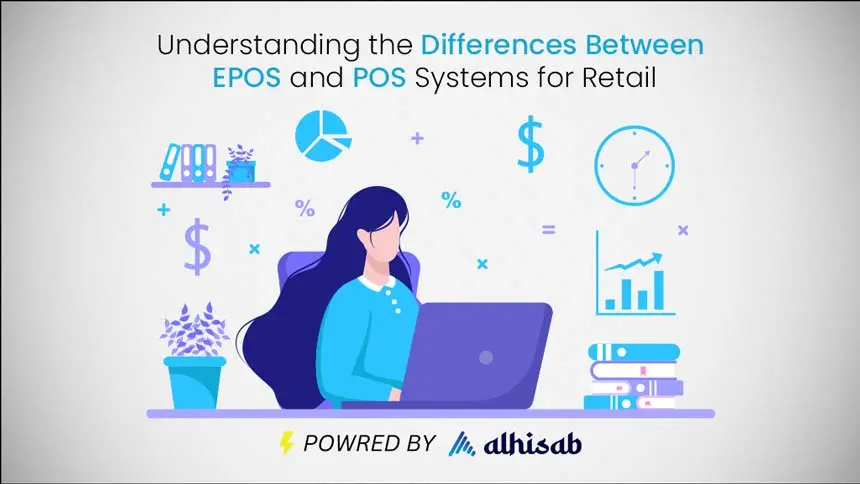Point of Sale (POS) Systems: A Point of Sale (POS) system serves as the hub of retail transactions, facilitating the exchange of goods or services for payment. Traditional POS systems include a cash register, barcode scanner, receipt printer, and payment processing hardware. Modern POS systems have evolved to encompass software solutions, which can be installed on computers, tablets, or smartphones. The primary focus of a POS system is on processing sales quickly and efficiently.
Electronic Point of Sale (EPOS) Systems: Electronic Point of Sale (EPOS) systems share many similarities with traditional POS systems but offer an extended range of features. EPOS systems are equipped with advanced inventory management, customer relationship management (CRM), and reporting capabilities. They provide retailers with detailed insights into sales trends, stock levels, customer preferences, and more. EPOS systems are particularly suitable for businesses with complex inventory needs and multiple sales channels.
Distinguishing Features:
Inventory Management: EPOS systems excel in inventory management, enabling retailers to monitor stock levels, track products, and automate reordering processes. This feature is especially beneficial for businesses with a wide range of products or multiple locations. POS systems typically offer basic inventory tracking, but EPOS systems provide a more comprehensive and robust solution.
CRM and Customer Insights: EPOS systems go beyond mere transaction processing by offering customer insights and CRM functionalities. Retailers can collect and analyze data to personalize customer experiences, run targeted marketing campaigns, and build lasting relationships. POS systems may integrate with third-party CRM tools but do not inherently provide the same depth of customer-focused features.
Reporting and Analytics: EPOS systems provide in-depth reporting and analytics tools that empower retailers to make informed decisions. These systems generate detailed reports on sales, inventory turnover, employee performance, and more. POS systems offer basic sales reports but lack the comprehensive analytical capabilities of EPOS systems.
Multi-Channel Support: EPOS systems are designed to handle multiple sales channels, including physical stores, online platforms, and even mobile apps. This versatility enables retailers to manage inventory and sales seamlessly across various channels. POS systems may not be as adaptable to multi-channel operations without additional integrations.
Choosing the Right System for Your Retail Business: Selecting between an EPOS and a POS system depends on your business needs and scale. Here are some considerations to help you decide:
Business Size: Small retailers with straightforward operations may find a traditional POS system sufficient. Larger businesses with complex inventory management and multi-channel sales will benefit from an EPOS system’s advanced capabilities.
Features Required: If you require detailed inventory management, CRM, and robust reporting, an EPOS system is the more suitable choice. If your primary focus is on quick and efficient transaction processing, a POS system might suffice.
Scalability: EPOS systems are inherently more scalable, accommodating the growth of your retail business across multiple locations and sales channels.
Conclusion: Both EPOS and POS systems play pivotal roles in modern retail, each catering to specific operational needs. While POS systems are geared towards efficient transaction processing, EPOS systems offer an all-encompassing solution with advanced inventory management, CRM, and analytical capabilities. When choosing between the two, retailers should assess their business requirements, size, and future growth prospects to make an informed decision that aligns with their goals. Regardless of the choice, integrating the right system will undoubtedly contribute to improved customer experiences and streamlined retail operations.
Advantages of POS systems
Disadvantages of POS systems
POS Systems:
Definition and features of POS systems: POS systems comprise a computer or tablet, a barcode scanner, a cash register, and a receipt printer. The software component manages inventory, tracks sales, and stores customer information. The software can also make reports about sales data, inventory levels, and how customers buy things, which can be very helpful for running a business.
Benefits of using POS systems in retail: The benefits of using a POS system in retail are numerous. One of the most important benefits is that it makes transaction processing more accurate and faster. POS systems make it easier to keep track of inventory and less likely to overstock or run out of items. They can also make sales reports in real-time, which gives business owners important information they can use to make good decisions. POS systems can also help businesses keep track of customer information, leading to more personalized customer experiences and more effective marketing.
Common three types of POS systems: Traditional POS systems are stationary systems requiring an electrical outlet and a dedicated computer. Traditional POS systems usually have advanced features like managing multiple registers, handling high transaction volumes, and working with other business systems like accounting software.
Mobile POS systems: These systems are designed to be used on mobile devices like tablets and smartphones. They are perfect for small and medium-sized businesses that need a flexible and portable option. Mobile POS systems can work on a wireless network or through a mobile data connection. This lets retailers process transactions from anywhere.
Cloud-based POS systems: These systems operate entirely in the cloud, meaning that there is no need for a physical server or computer. They offer real-time access to sales data, inventory levels, and customer data, making managing business operations from anywhere more accessible. Cloud-based POS systems are easy to set up and can be accessed from any internet-connected device.
Advantages of EPOS systems
1. Improved accuracy: EPOS systems are less prone to human error, ensuring more accurate transactions and inventory management.
2. Increased efficiency: EPOS systems can process transactions quickly, reducing wait times for customers and improving the overall efficiency of the sales process.
3. Enhanced data management: EPOS systems can provide detailed sales reports and real-time inventory tracking, allowing businesses to make data-driven decisions.
4. Improved customer experience: EPOS systems can make transactions smoother and more convenient for customers, with features such as contactless payments and digital receipts.
5. Scalability: EPOS systems can be scaled up or down as needed, making them suitable for businesses of all sizes.
Disadvantages of EPOS systems
1. Initial costs: Implementing an EPOS system can be expensive, particularly for small businesses.
2. Technical issues: EPOS systems can be vulnerable to technical malfunctions or downtime, which can impact sales and productivity.
3. Training and maintenance: Staff require training to use EPOS systems, and ongoing maintenance may be required to ensure smooth operation.
4. Security risks: EPOS systems store sensitive customer and financial data, making them a potential target for cyber attacks or data breaches.
5. Limited functionality: Some EPOS systems may have limited functionality or customization options, which may not meet the specific needs of all businesses.
EPOS Systems
Definition and Features of EPOS Systems: EPOS systems use special software to handle sales, keep track of inventory, and gather customer information. They can be used for various businesses, including supermarkets, department stores, and restaurants. EPOS systems typically include a computer, touch screen monitor, barcode scanner, and cash drawer, and are designed to be easy to use for employees and customers.
Sales Management: EPOS systems are designed to process sales transactions quickly and accurately, which can help reduce wait times for customers and increase sales for businesses.
Inventory Management: EPOS systems can keep track of inventory levels, let business owners know when stock is running low, and help automate reordering.
Customer Management: EPOS systems can store customer data, such as purchase history and contact information, which can help businesses personalize their marketing efforts and improve customer loyalty.
Reporting and Analytics: EPOS systems can generate reports on sales, inventory, and customer data, which can help businesses make informed decisions about their operations.
Benefits of Using EPOS Systems in Retail
Improved Efficiency: EPOS systems can help businesses process sales transactions more quickly and accurately, reducing customer wait times and increasing sales.
Better Inventory Management: EPOS systems can track inventory levels, automate the reordering process, and reduce the risk of stock shortages.
Personalized Customer Experience: EPOS systems can store customer data, which can help businesses personalize their marketing efforts and improve customer loyalty.
Real-time data processing and analysis: EPOS systems can make reports on sales, inventory, and customer data in real time, which helps businesses make smart decisions about their operations.
Common Types of EPOS Systems
Traditional EPOS Systems: Traditional EPOS systems are computer-based systems that require hardware installation and are typically used in larger businesses. They offer a range of features, including sales and inventory management, and can be customized to meet the specific needs of a business.
Mobile EPOS Systems: Mobile EPOS systems are software-based systems that can be used on mobile devices like smartphones and tablets. They are ideal for small businesses or businesses that require mobility, such as food trucks or pop-up shops.
Cloud-based EPOS Systems: Cloud-based EPOS systems are web-based systems requiring an internet connection. They offer a range of features, including sales and inventory management, and can be accessed from anywhere with an internet connection.
Key Differences Between EPOS and POS Systems: Hardware, Software, and Functionality
Hardware Differences
Computer Requirements: Traditional POS systems typically rely on a dedicated computer terminal that runs software designed specifically for the system. In contrast, EPOS systems can run on a standard PC or tablet that businesses can purchase from any vendor. This makes EPOS systems more flexible and cost-effective.
Peripheral Devices: Traditional POS systems require specific hardware peripherals, such as barcode scanners, cash drawers, and receipt printers. EPOS systems support a wider range of peripheral devices, so businesses can tailor their POS system to their needs.
Software Differences
Data Storage and Accessibility: Traditional POS systems store data locally, whereas EPOS systems store data on the cloud, making it easier to access data from anywhere and ensuring that data is safe and secure.
User Interface: EPOS systems have a more user-friendly interface, touchscreens, and intuitive controls. Traditional POS systems may require more training and have a steeper learning curve.
Functionality Differences
Transaction Processing: EPOS systems can handle transactions more quickly and efficiently with features like contactless payments and automatic calculations. Traditional POS systems may require manual input and can be slower.
Inventory Management: EPOS systems offer more advanced inventory management features, such as automated stock replenishment and real-time inventory tracking. Traditional POS systems may require manual inventory tracking.
Customer Relationship Management: EPOS systems offer more advanced customer relationship management features, such as loyalty programs and customer data tracking. Traditional POS systems may not have these features.
Factors to Consider When Choosing Differences Between EPOS and POS Systems
Business Size and Type: The size and type of your business can impact your choice of EPOS or POS system. A traditional POS system might be enough for a small business with a few employees and a small inventory. Still, a more advanced EPOS system might be better for a larger business with more complicated operations. Similarly, the type of business you operate may also influence your decision. For example, a retail store might benefit more from an EPOS system with advanced inventory management features. At the same time, a restaurant may need a POS system with features designed for the food service industry.
Budget and Cost Considerations: Budget is a key factor when choosing between EPOS and POS systems. EPOS systems are generally more expensive than traditional POS systems, but they offer more advanced features that can improve business operations and enhance the customer experience. Businesses should weigh the cost of the system against the potential benefits and return on investment (ROI) to determine if an EPOS system is the right choice for their business.
Scalability and Future Growth: Another important factor to consider is the scalability of the system and your business’s potential for future growth. EPOS systems are more flexible and easy to change than traditional POS systems, so they can meet the needs of a growing business as it changes. Traditional POS systems are better for smaller businesses that don’t plan to grow or expand much in the future.
Integration with Existing Systems: Businesses with a system should consider how well the new system will work and connect to their current infrastructure. EPOS systems may offer more integrations and compatibility with other software and systems, while traditional POS systems may have more limited options.
Customer Needs and Preferences: Finally, businesses should consider their customer’s needs and preferences when choosing between EPOS and POS systems. With advanced features like contactless payments and personalized recommendations, EPOS systems can improve the customer experience. However, traditional POS systems may still be preferred by some customers who are more familiar with them.
Conclusion - Differences Between EPOS and POS
In conclusion, Differences between EPOS and POS systems depends on several factors such as business size and type, budget, scalability, and customer needs. While EPOS systems offer advanced features such as real-time data processing and analysis, inventory management, and personalized customer experience, they come with higher costs and complexity. On the other hand, POS systems are simple, cost-effective, and suitable for small and medium-sized businesses, but have limited functionality and scalability.







